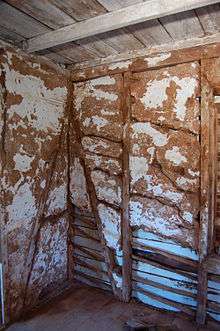Bousillage

Bousillage (bouzillage,[1] bousille, bouzille) is a mixture of clay and grass or other fiberous substances used as the infill (chinking) between the timbers of a half-timbered building. This material was commonly used by 18th century French colonial settlers in the historical New France region of the United States and is similar to the material cob and adobe. In French torchis has the same meaning or the meaning of a loaf of this material.[1]
Discussion
Bousillage in south Louisiana is a mixture of clay earth and retted Spanish moss, but in the Upper Mississippi River Valley and Canada contains straw, grass or hair,[1] used to fill in the panels in poteaux-sur-sol, poteaux-en-terre, and half-timbered framing (called colombage in French).[2] This was a technique used in French Louisiana by colonists from the 18th to 19th centuries. In France the framing was typically in-filled between the post with brick (briquette-entre-poteaux), stone and mud (Pierrotage) or bousillage. There was no stone in south Louisiana, and bricks were not being made during early colonial times. The colonist picked up on a technique that the Native Americans were using to build their wattle and daub structures, and that was heavy clay soil and retted Spanish moss as the binder. Split sticks or staves, known as barreaux, rabbits or batons were used as rungs between the upright post. They were shaped to fit at an angle and hammered into place without the use of nails.
Bousillage is made by layering a taché (hole in the ground) with mud and moss and adding water.[3] Then tacherons (barefoot men) worked the mixture into a mortar. Torchis (bousillage shaped like a bread dough loaf) are hung over the barreaux being compacted as placed one next to the other. The finished wall would have been either lime washed or covered with lime plaster. The plaster contains animal hair as a binder.[4]
Gallery of structures using bousillage
 La Maison de Guibourd Historic House in Ste. Genevieve, Missouri is an example of poteaux-sur-solle construction.
La Maison de Guibourd Historic House in Ste. Genevieve, Missouri is an example of poteaux-sur-solle construction. A model of the Maison Bolduc showing poteaux-sur-solle construction.
A model of the Maison Bolduc showing poteaux-sur-solle construction. Maison Bolduc is an example of poteaux-sur-solle construction.
Maison Bolduc is an example of poteaux-sur-solle construction. The Durand Cabin is an example of poteaux-sur-solle construction.
The Durand Cabin is an example of poteaux-sur-solle construction.
See also
- La Maison de Guibourd
- Ste. Genevieve, Missouri
- New France
- French colonization of the Americas
- French architecture
- Poteaux-en-terre
References
- 1 2 3 McDermott, John Francis. "bousillage, bouzillage, n. m.". A Glossary of Mississippi Valley French, 1673-1850. St. Louis: , 1941. 34. Print.
- ↑ Edwards, Jay Dearborn, and Nicolas Verton. A Creole lexicon architecture, landscape, people. Baton Rouge: Louisiana State University Press, 2004. 32. Print.
- ↑ Blokker, Laura Ewen and Heather A. Knight. "Louisiana’s Bousillage Tradition: Investigation of Past Techniques for Future Practice". 2009 Fitch Mid-Career Grant. 2011. Print. accessed April 7, 2015
- ↑ Louisiana Vernacular Gumbo, by Edward Cazayoux and A Manual for the Environmental & Climatic Responsive Restoration & Renovation of Older Houses in Louisiana, by Edward Cazayoux
External links
| Wikimedia Commons has media related to Bousillage. |